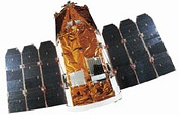EROS (satellite)
This article relies largely or entirely on a single source. (March 2014) |
 EROS-B Satellite | |
| Manufacturer | IAI |
|---|---|
| Country of origin | Israel |
| Operator | ImageSat International |
| Production | |
| Status | Active |
| Built | 2 known |
| Launched | 2 |
| Maiden launch | EROS A, December 5, 2000 |
| Last launch | EROS B, April 25, 2006 |
Earth Resources Observation Satellite (EROS) is a series of Israeli commercial Earth observation satellites, designed and manufactured by Israel Aircraft Industries (IAI), with optical payload supplied by El-Op. The satellites are owned and operated by ImageSat International, another Israeli company, with some 35 full-time employees (of IntelSat's total of 50). EROS A was launched, on December 5, 2000 and EROS B on April 25, 2006.
Satellites
EROS A
EROS A was launched on the Russian Start-1 launcher on December 5, 2000, from the Svobodny Launch Complex in eastern Siberia, to a Low Earth orbit (LEO) altitude of 480 km. The satellite provides commercial images with an optical resolution of 1.8 meters. The satellite orbits earth in a sun synchronous orbit, so that its imaged target is always in daylight. It always crosses the equator at 9:45am local time.
Its dimensions: height: 2.3 m, diameter: 1.2 m, head: 0.7 m. It weighed 250 kg at launch. It was built based on the military reconnaissance satellite Ofeq 3, which was previously built, also by IAI and El-Op, for Israeli government use.
EROS B
ImageSat initially planned to launch a similar satellite every 6 years after EROS A.
EROS B was finally launched on April 25, 2006 aboard a Russian Start-1 rocket from the Svobodny Launch Complex in eastern Siberia. The satellite offers an optical resolution of 70 cm (about two feet), and as of launch date plans were to use it to monitor Iran's developing nuclear program for potential threats to Israeli security.
Plans
This section needs to be updated. (March 2014) |
In January 2011, it was stated that work would begin "in the near term" on a new EROS C satellite.[1]
ImageSat announced plans to launch a total of three more satellites in later dates, in order to provide full coverage of the entire planet surface with six functional satellites.[citation needed]
See also
References
- ^ "Israel's ImageSat Sheds Some Legal Baggage". Retrieved 2011-02-10.
